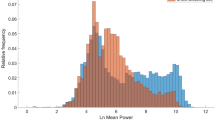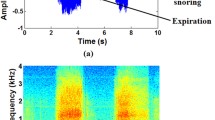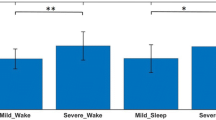Abstract
While considerable efforts have been expended to develop snore-driven markers for detecting obstructive sleep apnea (OSA), there is little emphasis on the relationship between the human upper airway (UA) dimensions and the attributes of snores. This paper aims to investigate the acoustical and perceptual impacts of changing the cross-sectional areas (CSA) of the pharynx and oral cavity on the production of snores. Synthetic snores were generated based on the source-filter theory, whereas natural snores were recorded from 40 snorers during nocturnal polysomnography. First formant frequency (F1), spectral peak frequency (PF), and psychoacoustic metrics (loudness, sharpness, roughness, fluctuation strength, and annoyance) of CSA perturbations were examined, completed with diagnostic appraisal of F1 and PF for single- and mixed-gender groupings using the receiver operating characteristic curve analysis. Results show that (1) narrowing the pharyngeal airway consistently increases F1, but not for PF; and (2) altering the airway dimensions yield no considerable differences in perception of snore sounds, but indirectly affect the psychoacoustics by changing the dynamics of snore source flow. Diagnostic outcomes for all groupings (p-value < 0.0001) demonstrate that F1 is more capable of distinguishing apneic and benign snorers than PF due to the close association of F1 with the UA anatomical structures. Correlation exists between the UA anatomy and the properties of snores; there is a promising future for developing snore-driven screening tools for OSA.





Similar content being viewed by others
References
Airas, M. TKK Aparat: an environment for voice inverse filtering and parameterization. Logoped. Phoniatr. Vocol. 33(1):49–64, 2008.
Akaike, H. Power spectrum estimation through autoregression model fitting. Ann. Inst. Stat. Math. 21:407–419, 1969.
Akaike, H. A new look at the statistical model identification. IEEE Trans. Automat. Contr. 19:719–723, 1974.
Beck, R., M. Odeh, A. Oliven, and N. Gavriely. The acoustic properties of snores. Eur. Respir. J. 8(12):2120–2128, 1995.
Bertino, G., E. Matti, S. Migliazzi, F. Pagella, C. Tinelli, and M. Benazzo. Acoustic changes in voice after surgery for snoring: preliminary results. Acta Otorhinolaryngol. Ital. 26(2):110–114, 2006.
Bertram, C. D. Flow-induced oscillation of collapsed tubes and airway structures. Respir. Physiol. Neurobiol. 163(1–3):256–265, 2008.
Cavusoglu, M., T. Ciloglu, Y. Serinagaoglu, M. Kamasak, O. Erogul, and T. Akcam. Investigation of sequential properties of snoring episodes for obstructive sleep apnoea identification. Physiol. Meas. 29(8):879–898, 2008.
Childers, D. G. Speech Processing and Synthesis Toolboxes. New Yrok: Wiley, 1999
Chouly, F., A. Van Hirtum, P. Y. Lagree, X. Pelorson, and Y. Payan. Modelling the human pharyngeal airway: validation of numerical simulations using in vitro experiments. Med. Biol. Eng. Comput. 47(1):49–58, 2009.
Dalmasso, F., and R. Prota. Snoring: analysis, measurement, clinical implications and applications. Eur. Respir. J. 9(1):146–159, 1996.
de Cheveigne, A., and H. Kawahara. YIN, a fundamental frequency estimator for speech and music. JAS 111(4):1917–1930, 2002.
Deller, J. R., J. H. L. Hansen, and J. G. Proakis. Discrete-Time Processing of Speech Signals. NJ: Wiley-IEEE Press, 1999
El-Jaroudi, A., and J. Makhoul. Discrete all-pole modeling. IEEE Trans. Signal Process. 39(2):411–423, 1991.
Fant, G. Acoustic Theory of Speech Production. The Hague: Mouton, 1960
Fastl, H., and E. Zwicker. Psychoacoustics: Facts and Models. New York: Springer, 2007
Gavriely, N., and O. Jensen. Theory and measurements of snores. J. Appl. Physiol. 74(6):2828–2837, 1993.
Hara, H., N. Murakami, Y. Miyauchi, and H. Yamashita. Acoustic analysis of snoring sounds by a multidimensional voice program. Laryngoscope 116(3):379–381, 2006.
Ikeda, K., M. Ogura, T. Oshima, H. Suzuki, S. Higano, S. Takahashi, H. Kurosawa, W. Hida, H. Matsuoka, and T. Takasaka. Quantitative assessment of the pharyngeal airway by dynamic magnetic resonance imaging in obstructive sleep apnea syndrome. Ann. Otol. Rhinol. Laryngol. 110(2):183–189, 2001.
Jung, D. G., H. Y. Cho, R. R. Grunstein, and B. Yee. Predictive value of kushida index and acoustic pharyngometry for the evaluation of upper airway in subjects with or without obstructive sleep apnea. J. Korean Med. Sci. 19(5):662–667, 2004.
Koutsourelakis, I., E. Vagiakis, C. Roussos, S. Zakynthinos, and C. Roussos. Obstructive sleep apnoea and oral breathing in patients free of nasal obstruction. Eur. Respir. J. 28(6):1222–1228, 2006.
Ladefoged, P. A Course in Phonetics. Belmont, CA: Wadsworth Publishing, 2005
Ljung, L. System Identification: Theory for the User. Upper Saddle River, NJ: Prentice Hall PTR, 1998
Makhoul, J. Linear prediction: a tutorial review. Proc. IEEE 63(4):561–580, 1975.
Markel, J. D., and A. H. Gray. Linear Prediction of Speech. New York: Springer-Verlag, 1976
Michael, H., S. Andreas, B. Thomas, H. Beatrice, H. Werner, and K. Holger. Analysed snoring sounds correlate to obstructive sleep disordered breathing. Eur. Arch. Otorhinolaryngol. 265(1):105–113, 2008.
Mohsenin, V. Effects of gender on upper airway collapsibility and severity of obstructive sleep apnea. Sleep Med. 4(6):523–529, 2003.
Ng, A. K., Z. J. Ho, and T. S. Koh. Effects of microphone position on snore signal quality and patient comfort. In: Proceedings of the International Conference on Signal Processing, pp. 2130–2133, 2008.
Ng, A. K. and T. S. Koh. A high-fidelity acquisition system for snore signals: design and implementation. In: Proceedings of the IEEE Instrumentation and Measurement Technology Conference, pp. 189–193, 2007, art. no. 4258108.
Ng, A. K. and T. S. Koh. Using psychoacoustics of snoring sounds to screen for obstructive sleep apnea. In: Proceedings of Annual International Conference of the IEEE Engineering in Medicine and Biology, pp. 1647–1650, 2008.
Ng, A. K., T. S. Koh, E. Baey, T. H. Lee, U. R. Abeyratne, and K. Puvanendran. Could formant frequencies of snore signals be an alternative means for the diagnosis of obstructive sleep apnea? Sleep Med. 9(8):894–898, 2008.
Ng, A. K., T. S. Koh, K. Puvanendran, and U. R. Abeyratne. Snore signal enhancement and activity detection via translation-invariant wavelet transform. IEEE Trans. Biomed. Eng. 55(10):2332–2342, 2008.
Ng, A. K., K. Y. Wong, C. H. Tan, and T. S. Koh. Bispectral analysis of snore signals for obstructive sleep apnea detection. In: Proceedings of Annual International Conference of the IEEE Engineering in Medicine and Biology, pp. 6196–6199, 2007.
Ogawa, T., R. Enciso, W. H. Shintaku, and G. T. Clark. Evaluation of cross-section airway configuration of obstructive sleep apnea. Oral Surg. Oral Med. Oral Pathol. Oral Radiol. Endod. 103(1):102–108, 2007.
Owens, F. J. Signal Processing of Speech. London: Macmillan, 1993
Park, S., C. Kim, and I. Jung. Metric study of upper airway and trachea in normal Korean adults using fiberoptic bronchoscopy: study of endotracheal tube fixation positioning in adults. Korean J. Anesthesiol. 31(6):733–738, 1996.
Rechtschaffen, A. and A. Kales. A Manual of Standardized Terminology, Techniques and Scoring System for Sleep Stages of Human Subjects. Los Angeles: Brain Information Service/Brain Research Institutes, University of California, 1968.
Rissanen, J. A universal prior for integers and estimation by minimum description length. Ann. Stat. 11(2):416–431, 1983.
Stoica, P., and R. L. Moses. Spectral Analysis of Signals. Upper Saddle River, NJ: Prentice Hall, 2005
Stuck, B. A., and J. T. Maurer. Airway evaluation in obstructive sleep apnea. Sleep Med. Rev. 12(6):411–436, 2008.
Sun, X., C. Yu, Y. Wang, and Y. Liu. Numerical simulation of soft palate movement and airflow in human upper airway by fluid-structure interaction method. Acta Mechanica Sinica/Lixue Xuebao 23(4):359–367, 2007.
Zhang, Z., and C. Y. Espy-Wilson. A vocal-tract model of American English /l/. JAS 115(3):1274–1280, 2004.
Zweig, M. H., and G. Campbell. Receiver-operating characteristic (ROC) plots: a fundamental evaluation tool in clinical medicine. Clin. Chem. 39(4):561–577, 1993.
Acknowledgments
The authors thank the group of polysomnographic technicians and signal processing specialists for their involvement and support in this study.
Author information
Authors and Affiliations
Corresponding author
Rights and permissions
About this article
Cite this article
Ng, A.K., Koh, T.S., Baey, E. et al. Role of Upper Airway Dimensions in Snore Production: Acoustical and Perceptual Findings. Ann Biomed Eng 37, 1807–1817 (2009). https://doi.org/10.1007/s10439-009-9745-7
Received:
Accepted:
Published:
Issue Date:
DOI: https://doi.org/10.1007/s10439-009-9745-7




